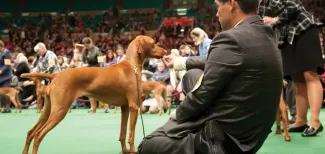Raising and training a show dog that confidently enjoys the demands of a conformation career can make for a myriad of learning curves and bumps along the road.
My husband, Corky, and I spent a lifetime in dogs as busy all-breed professional handlers and had regular opportunities to observe and work with potential show dogs. Some were brought to us in the middle of their show career with issues and habits we had to diagnose and work through. We didn’t always have the advantage of starting potential winners with that all-important, first-time experience in the puppy class.
Among the reasons owners hire a professional handler are they do not enjoy handling and/or they feel they lack the skills to comfortably walk into the ring and be competitive. A common scenario is that a family member or friend exhibits the puppy in the puppy classes, and when the dog matures, the professional handler is hired to take over the lead.
Taking over a show dog that has not had the benefit of early ring training delays the “look at me” confidence necessary for ribbon consideration. When dogs with pre-existing issues crossed through our kennel doors, it was necessary to develop problem-solving methods of training to offset prior mistakes. Some had not been taught the basics of “stack/stay/let’s go” and had never been worked on proper equipment, such as collars and leads, for that breed.
Seldom, if ever, did we take on a new client and dog sight unseen. After an initial assessment of the dog, and our understanding of the owner’s goals and expectations, we designed a training and conditioning schedule suited for the dog’s individual needs. Mostly, these were for dogs that didn’t have the advantage of early positive exposure to show rings and had some prior bad experiences.
Among problems that may need corrected are insecurities in dogs suffering from low self-esteem and lack of purpose. In the case of a Sporting dog that came to us lacking confidence, we started by allowing him freedom in a large park dragging a 20-foot lead line with one of us at the end of the line following him wherever he wanted to go. He began to understand that he didn’t have to lag behind us as his shield. As time passed, we planted treats on the route and let him find them. Eventually, the lead line was shortened, and we allowed him to feel contact with the lead and his collar. Running ahead to find goodies became an esteem-building accomplishment for him.
The buddy system among kennelmates, or “social learning,” also can be an effective confidence builder. In working with a Pug that put the brakes on almost every time she came close to the show ring due to anxiety from unfamiliar sounds and situations, we kenneled her next to a gregarious Boston Terrier that loved to show.
On numerous occasions, the two were put on leads and led toward the show ring area with the Boston in front. When attention and treats were offered by others to the Boston Terrier, we asked that no interaction with the Pug occur, other than merely letting her observe the reaction and willingness of the Boston to receive the attention. Forcing a dog into a situation he or she is not ready to accept can do irreparable damage and will only reinforce the fear. Gradually, after repetition of positive social experiences, the Pug was able to enter the ring and finish her championship with confidence.
Working through a bad experience involves patience. It is important to know exactly what occurred, where and how. Too often, fearful behavior is reinforced by overcompensating with pampering and petting the minute a dog enters a “scary zone.”
This only serves to strengthen and encourage the anxious behavior of the dog. It is important that the dog be allowed to stand in his or her own space and watch what is going on. Owning his ground while accompanied by a person he trusts requires no pampering and cooing.
Inappropriate use of baiting can happen when bait becomes the poor replacement for show ring training. Feeding and baiting are separate actions. Qualified professional handlers should be expected to recognize the difference between rewarding a dog for a desired behavior and simply stuffing his mouth with food in order to distract and restrain.
Bait should be subtly visible only to alert when a judge is evaluating head and expression and then given once the exam is complete. Overuse of food will diminish a dog’s desire to give that intense, focused expression, not to mention annoy a judge who sees the hand in front of the face or a mouth and teeth full of food.
Training and retraining negative learned behavior takes time. It requires a great deal of patience, repetition and often inventive thinking. Nothing happens overnight except maybe the setting of poured concrete. It’s easier to pour it right the first time than jackhammer it up later.
A professional all-breed handler for 32 years, Sue Vroom and her late husband, Corky Vroom, won hundreds of Bests in Show during their career. Vroom, of Denton, Texas, works as an Executive Field Representative for the American Kennel Club. For information, contact Vroom at 940-497-4500 or by e-mail at suevroom@centurytel.net.

